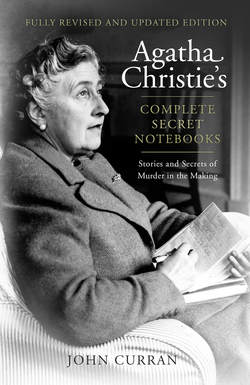Читать книгу Agatha Christie’s Complete Secret Notebooks - Агата Кристи, Agatha Christie, Detection Club The - Страница 72
Other Crime Writers in the Notebooks
ОглавлениеApart from the ‘13 at Dinner’ list in Notebook 41, Agatha Christie makes other references to her fellow crime writers. The following is a selection of those mentioned:
E.C. Bentley
Apart from his appearance in connection with the Detection Club, he is also referred to in Notebook 41. The following concerns a contribution to Bentley’s anthology A Second Century of Detective Stories, published in 1938, where ‘The Case of the Distressed Lady’ from Parker Pyne Investigates represents Christie
A HP story for Bentley
G.K. Chesterton
The creator of Father Brown, the immortal priest detective, and first president of the Detection Club, Chesterton contributed to their collaborative novel The Floating Admiral. The reference in Notebook 66 is a reminder to provide a short story for him, presumably for his 1935 anthology A Century of Detective Stories. She did not write a new one but instead provided ‘Sing a Song of Sixpence’.
Ideas for G. K. C.
John Creasey
In Notebook 52 there are two references, both very similar, to John Creasey, British crime writer of almost 600 books. Hugely prolific under a variety of pseudonyms, he was also a founder of the Crime Writers Association. In The Clocks, the typewriting agency, which is the focus of much of the novel, does some work for Creasey-like authors.
Miss M[artindale] is chief agent – Sec[retary] to Creasey – who wrote spy stories
Rufus King
Twice during the plotting of Mrs McGinty’s Dead Christie mentions Murder by Latitude, a novel by this largely forgotten US writer. Murder by Latitude features a typical Christie setting, aboard a ship from which contact with land has been severed. Although not mentioned by name, there are a few of his novels in the library at Greenway House.
Atmosphere like Murder by Latitude – some people – amongst them a Murderer
A.E.W. Mason
Mason was the creator of Inspector Hanaud. The reference in Notebook 35 is to At the Villa Rose, published in 1910, a case involving the death of an elderly woman and the suspicion surrounding her companion. While plotting One, Two, Buckle my Shoe Christie reminds herself of it:
A murder discovered (woman? Elderly? Like Villa Rose) Clue – a shoe buckle
Edgar Allan Poe
The ‘inventor’ of the detective story when he published ‘The Murders in the Rue Morgue’ in 1841. ‘The Purloined Letter’, another famous case for his detective Auguste Dupin, turns on the idea of hiding in plain sight and Christie’s reference is in connection with a fortune hidden not in but on an envelope, as stamps. She used this plot device in the short story ‘Strange Jest’ and in Spider’s Web. The concept of hiding in plain sight is also used in ‘The Nemean Lion’.
Stamps – fortune left in them – on old letters in desk – ‘Purloined Letter’ mentioned – they look in obvious envelope – really stamps on it
Dorothy L. Sayers
Sayers’ creation Lord Peter Wimsey made his debut in 1923 in Whose Body? and is mentioned in Notebook 41, as a model for Ronnie West in Lord Edgware Dies. It is also possible that the naming of Dr Peter Lord in Sad Cypress is homage to Christie’s great contemporary.
Ronnie West (debonair Peter Wimseyish)
